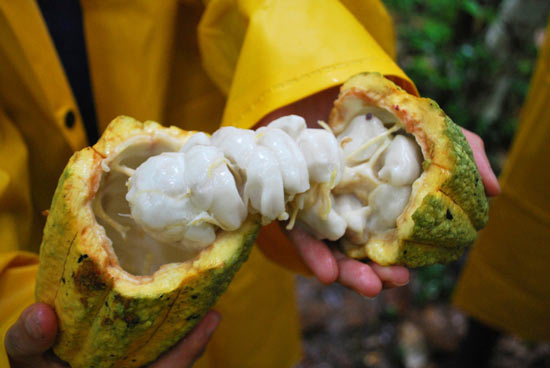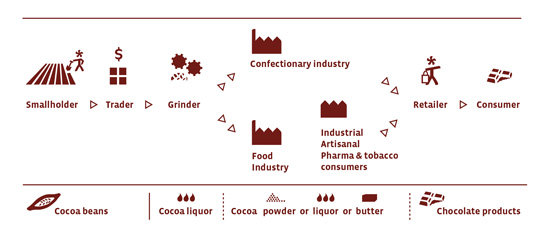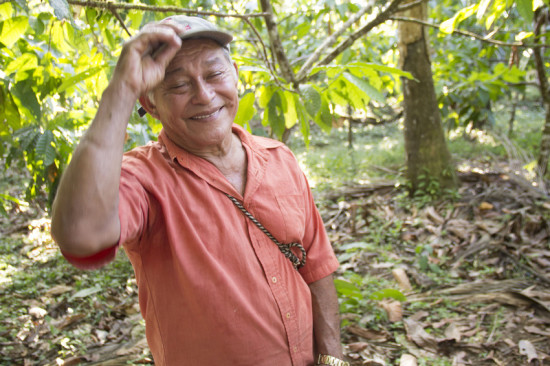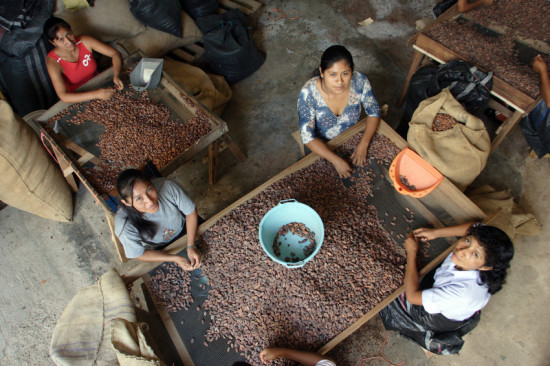Chocolate. It’s almost a food group unto itself. Whether you are personally a fan or not, you probably know someone who absolutely loves a rich, delicious piece of chocolate from time to time.
That love of chocolate helps spur the global demand for cocoa — a $110 billion per year industry.
Think you know all there is to know about this lucrative crop? Read on! You may learn something new. Then share your thoughts in the comments.
1. Cocoa and chocolate are two very different things.
In fact cocoa starts out looking like this.

That’s not a cocoa bean but a cocoa pod. It grows at the base of the cocoa tree. In a good year, a cocoa tree can produce 20 -30 pods, each of which contains between 20-50 almond sized cocoa beans.
From there cocoa beans go through many steps before they even arrive to a chocolate maker. Beans must be fermented and dried, tested for quality and then, finally, processed into chocolate. In fact, here’s a cool infographic about the steps a cocoa bean goes through to become chocolate.
 This infographic shows how cocoa gets produced, from smallholder farmers to consumers. Image by CocoaBarometer.org
This infographic shows how cocoa gets produced, from smallholder farmers to consumers. Image by CocoaBarometer.org
LWR works in Africa, Latin America and Asia to help smallholder farmers grow and sell quality cocoa to improve their incomes and lives.
2. Most of the world’s cocoa is produced in Africa.
While Europe and the U.S. are top chocolate-making regions, most of the world’s cocoa is grown in Africa. And within Africa, more than half — about 59 percent — is grown in West Africa, especially in Cote d’Ivoire and Ghana.
3. It takes five years after planting cocoa seedlings for trees to grow cocoa beans.
In many ways, growing cocoa is an investment — for farmers and for organizations like LWR who work with cocoa producers.
Cocoa can also be a tricky crop to produce. It takes a mixture of the right climate, proper plant placement and shading and good agricultural practices to grow thriving cocoa trees.
For these reasons, Mario Isabel Taicigue wasn’t so sure about growing cocoa on his farm in Nicaragua. But as a part of the local LWR cocoa project, he decided to give it a try. Now he’s growing cocoa and may even plant more. He’s also learned to grow other crops for income, so the wait time on cocoa harvesting is more manageable.

Through all his efforts Mario is growing so much more than cocoa on his farm. He’s planting a legacy to pass down to his children and grandchildren.
4. Many of the world’s cocoa producers have never tasted chocolate themselves.
When cocoa leaves the hands of the average cocoa farmer, it does so as a cocoa bean with several steps to becoming what we know and love as chocolate.

The steps — from cocoa bean to chocolate bar — make up the cocoa value chain. LWR works with cocoa cooperatives to participate in more parts of the cocoa value chain such as drying and fermenting beans, grinding them and, in places like Nicaragua, the families of some cocoa farmers have even come together to make chocolate.
The more steps of the cocoa value chain farmers are involved in, the more valuable their cocoa becomes. By helping farmers and cooperatives tap into the cocoa value chain, we can help farmers earn better incomes to support their families.
5. Despite cocoa being a lucrative – and growing – industry, many cocoa producers live in poverty.
Traditionally, most chocolate is produced by smallholder farmers and then sold at markets to middle-men, who go on to sell the cocoa large-scale buyers. Unfortunately this means most cocoa farmers see only a fraction of the total income earned from cocoa beans and the resulting products.
That’s one reason LWR works to support smallholder cocoa farmers. Through equitable systems, farmers work in cooperatives and are paid a fair price for their cocoa. They also receive what are called “social premiums” — additional money cooperatives use to make vital improvements to their communities, like maintaining schools, providing healthcare and installing wells.

